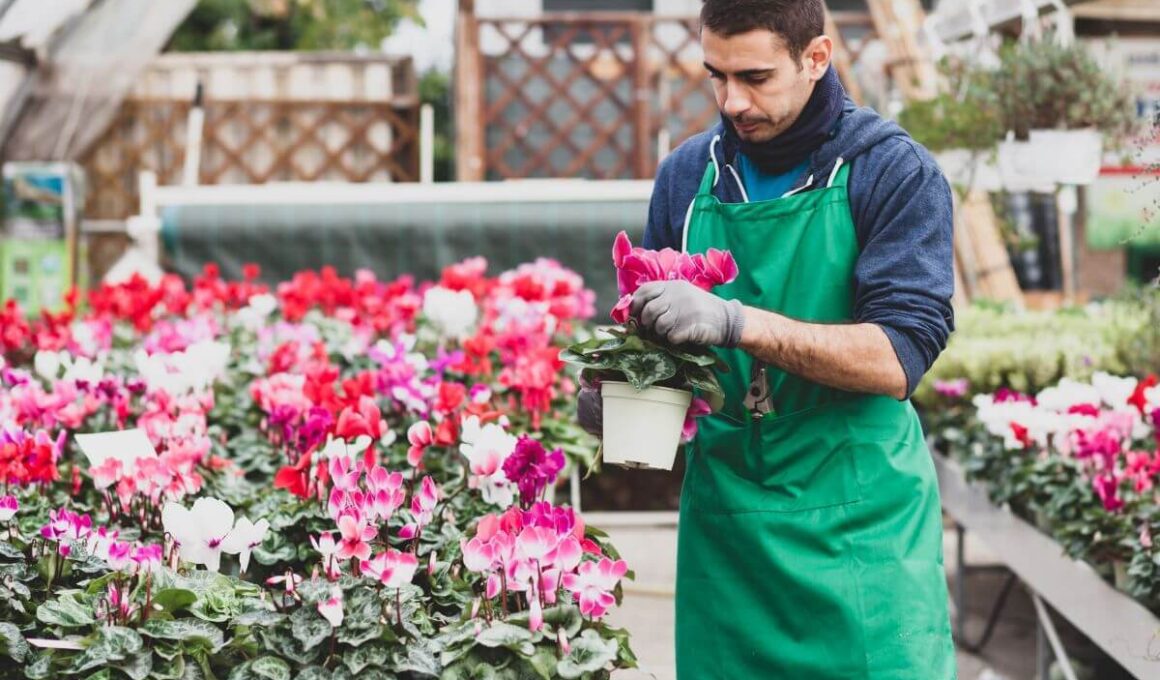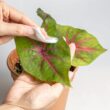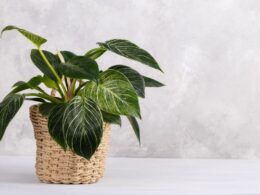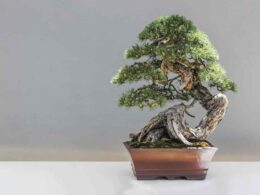What Is a Cyclamen Plant? Origin and Characteristics
Before we get into cyclamen plant care, let’s get to know it a bit. The cyclamen houseplant is a tuberous perennial that’s native to the Mediterranean region. It’s part of the Primulaceae family, which also includes primroses. There are 23 species in the Cyclamen genus, which gets its name from the plant’s circular tubers.
Cyclamens typically grow to be about six inches tall and have heart-shaped leaves. Their flowers – with petals uniquely swept upward – can be white, pink, red, or purple and bloom in late fall, winter or early spring, depending on the variety.
Cyclamen Plant Care – Soil Type and Fertilizer
Now that we know a bit more about cyclamen plants, let’s get started with cyclamen plant care. The first step is choosing the right potting mix. Cyclamens prefer loamy, well-draining soil. If your pot doesn’t have drainage holes, be sure to add some gravel to the bottom before adding the soil.
As far as fertilizer goes, cyclamens don’t need much. If you plan on keeping your plant after it blooms, a slow-release fertilizer applied once a year is sufficient. You can also fertilize every couple of months with a weak solution of water-soluble fertilizer (half the normal dose).
Fertilizing your cyclamen too much will encourage it to grow leaves instead of flowers. If your cyclamen is already in bloom, hold off on fertilizing until after it’s done flowering.
Cyclamen Plant Care – Watering
Now let’s talk about watering – a key part of cyclamen plant care. Cyclamens like evenly moist soil, but they don’t like to sit in water. Be sure to empty the drainage tray after watering so that the cyclamen’s roots don’t sit in water.
Overly dry or wet conditions can cause cyclamen leaves to yellow and die. During the summer, stop watering to allow your plant to go dormant. This is important if you want it to bloom next autumn or winter.
How Much Light Cyclamen Plants Need
The amount of light your plant gets is also important. Cyclamens do best in bright, indirect light. An east- or north-facing window is best. If you can provide this, great! But if not, don’t worry – cyclamens are fairly tolerant of lower-light conditions.
Just be sure to avoid direct sunlight, as it can scorch the foliage. If you notice the leaves turning yellow, this is a sign that your cyclamen is getting too much light or warmth.
Ideal Temperatures and Humidity for Cyclamen Plants
Speaking of warmth, cyclamen plants don’t like it too hot. They prefer cool temperatures, ideally between 40 and 50 degrees Fahrenheit at night and 60-70 during the day. If your home is on the warmer side, you may want to create a cooler spot for your cyclamen.
As far as humidity goes, cyclamens like it on the more humid side, especially during the winter. When your home is heated, the air can get quite dry. You can increase the humidity around your cyclamen by placing it on a pebble tray or using a humidifier.
Pruning or Deadheading Cyclamen Plants
Pruning isn’t a necessary part of cyclamen plant care. After the plant blooms, it will die back to the ground naturally. Alternatively, you can cut the stems back after the flowers have wilted. Your cyclamen will go into dormancy for the summer – at that point, put it in a cool and dark spot.
How to Propagate Cyclamen Plants
Cyclamen plants can be propagated by dividing their tubers. This is best done after the plant has gone dormant. However, it’s not recommended, as the delicate tubers will often rot. Growing cyclamen from seed is also difficult, so it’s best to buy an established plant in a pot.
If you do want to give it a try, carefully dig up the tuber and divide it into smaller pieces, making sure each piece has roots attached. Plant the tubers in well-draining soil, water, and keep them in a cool spot until they sprout.
Repotting Cyclamen Plants
Cyclamen plants don’t need to be repotted often. In fact, they actually prefer to be slightly pot-bound. Only repot when the plant has outgrown its pot. Do it in the summer when it’s dormant, and follow these steps:
- Choose a new pot that’s only slightly larger than the current one.
- Half-fill the new container with potting soil.
- Lift the cyclamen tuber out of its pot and gently brush off excess soil.
- Place the tuber in the new pot, leaving at least 2 inches between the rim and the tuber.
- Cover the tuber with potting soil.
- Place the new pot in a dry and shady spot for the rest of the summer.
- Start watering the plant again at the beginning of fall.
Common Problems with Cyclamen Plants
While cyclamen plant care is generally easy, there are a few problems you may encounter. These are:
- Leaves turning yellow. This is usually due to too much light or heat.
- Flowers wilting. This is normal after the plant has bloomed, but if it blooms poorly from the beginning, it’s a sign that the environment is too warm.
- Collapsed plants. This is usually due to overwatering or water splashing on the leaves and stems, causing the crown to rot.
- Cyclamen gray mold. This is a fungal disease that cyclamens are susceptible to. It’s characterized by gray or brown patches on the leaves, stems, and flowers. Too much humidity encourages the mold to grow.
Cyclamen Plant Toxicity
One final thing to keep in mind is that cyclamens contain poisonous saponins. All parts of the plant are toxic if ingested, so keep them away from pets and small children who may be tempted to taste them.
Now you know all about cyclamen plant care. With a little patience, you can enjoy these beautiful flowers in your home for years to come!



















